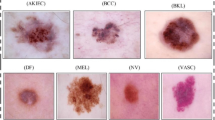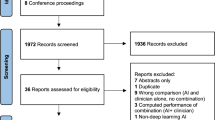Abstract
Skin cancer is a significant global health concern, with its early detection and diagnosis playing a pivotal role in improving patient health outcomes. In recent years, artificial intelligence (AI) has emerged as a transformative force in the field of dermatology, revolutionizing the way skin cancer is detected and diagnosed. This comprehensive survey paper delves into the realm of AI-enhanced early skin cancer diagnosis, offering a thorough examination of the state-of-the-art techniques, methodologies, and advancements in this critical domain. Our survey begins by providing a comprehensive overview of the different types of skin cancer, emphasizing the importance of early detection in preventing disease progression. It then explores the pivotal role that AI and machine learning algorithms play in automating the detection and classification of skin lesions, making dermatology more accessible and accurate. A critical analysis of various AI-driven approaches, including image-based classification, feature extraction, and deep learning models, is presented to elucidate their strengths and limitations. Furthermore, this survey examines the integration of AI into clinical practice, discussing real-world applications, challenges, and ethical considerations. It explores the potential of AI to assist dermatologists in making faster and more accurate diagnoses, ultimately enhancing patient care. The paper also addresses the need for large, diverse datasets and standardization in the development and validation of AI models for skin cancer diagnosis. In conclusion, “Revolutionizing Dermatology” presents a comprehensive synthesis of the current landscape of AI-enhanced early skin cancer diagnosis, offering insights into its transformative potential, challenges, and future directions. By bridging the gap between dermatology and cutting-edge AI technologies, this survey aims to facilitate informed decision-making among researchers, clinicians, and stakeholders in the pursuit of more effective skin cancer detection and treatment strategies.





Similar content being viewed by others
References
Mridha K, Uddin MM, Shin J, Khadka S, Mridha MF (2023) An interpretable skin cancer classification using optimized convolutional neural network for a smart healthcare system. IEEE Access 11(March):41003–41018, https://doi.org/10.1109/ACCESS.2023.3269694
Aravindan JSMMPC, Appavu R (2023) Classification of skin cancer from dermoscopic images using deep neural network architectures. Multimedia Tools Appl 82(10):15763–15778. https://doi.org/10.1007/s11042-022-13847-3
Gururaj HL, Manju N, Nagarjun A, Manjunath Aradhya VN, Flammini F (2023) DeepSkin: a deep learning approach for skin cancer classification. IEEE Access 11(May):50205–50214, https://doi.org/10.1109/ACCESS.2023.3274848
Yang G, Luo S, Greer P (2023) A novel vision transformer model for skin cancer classification. Neural Process Lett. https://doi.org/10.1007/s11063-023-11204-5
Alsahafi YS, Kassem MA, Hosny KM (2023) Skin-Net: a novel deep residual network for skin lesions classification using multilevel feature extraction and cross-channel correlation with detection of outlier. J Big Data 10(1). https://doi.org/10.1186/s40537-023-00769-6
Al-Rasheed A, Ksibi M, Ayadi AIA, Alzahrani M, Zakariah, Hakami NA (2022) An ensemble of transfer learning models for the prediction of skin cancers with conditional generative adversarial networks. Diagnostics 12(12). https://doi.org/10.3390/diagnostics12123145
Ahmad N et al (2023) A novel framework of multiclass skin lesion recognition from dermoscopic images using deep learning and explainable AI. Front Oncol 13:1–17. https://doi.org/10.3389/fonc.2023.1151257
Mukadam SB, Patil HY (2023) Applied sciences resolution generative adversarial network and custom convolutional neural network.
Arshed MA, Mumtaz S, Ibrahim M, Ahmed S, Tahir M, Shafi M (2023) Multi-class sk odels. Inform (Switzerland) 14(7). https://doi.org/10.3390/info14070415
Wang G, Yan P, Tang Q, Yang L, Chen J (2023) Multiscale feature fusion for skin lesion classification. Biomed Res Int 2023. https://doi.org/10.1155/2023/5146543
Imran A, Nasir M, Bilal G, Sun A, Alzahrani, Almuhaimeed A (2022) Skin cancer detection using combined decision of deep learners. IEEE Access 10(September):118198–118212, https://doi.org/10.1109/ACCESS.2022.3220329
Thanka MR et al (2023) A hybrid approach for melanoma classification using ensemble machine learning techniques with deep transfer learning. Comput Meth Prog Bio Update 3(April):100103, https://doi.org/10.1016/j.cmpbup.2023.100103
Lu X, Firoozeh Abolhasani YA, Zadeh (2022) Deep learning-based classification for melanoma detection using XceptionNet. J Healthc Eng. 2022:14–16. https://doi.org/10.1155/2022/2196096
Bassel AB, Abdulkareem ZAA, Alyasseri NS, Sani, Mohammed HJ (2022) Automatic malignant and benign skin cancer classification using a hybrid deep learning approach. Diagnostics 12(10). https://doi.org/10.3390/diagnostics12102472
Balaha HM, Hassan AES (2023) Skin cancer diagnosis based on deep transfer learning and sparrow search algorithm. Springer Lond 35(1). https://doi.org/10.1007/s00521-022-07762-9
Filali Y, Khoukhi HE, Sabri MA, Aarab A (2022) Analysis and classification of skin cancer based on deep learning approach. In 2022 International Conference on Intelligent Systems and Computer Vision (ISCV), pp. 1–6. https://doi.org/10.1109/ISCV54655.2022.9806087
Gadamsetty S, Ch R, Ch A, Iwendi C, Gadekallu T (2022) Hash-based deep learning approach for remote sensing satellite imagery detection. Water 14. https://doi.org/10.3390/w14050707
Hoang L, Lee SH, Lee EJ, Kwon KR (2022) Multiclass skin lesion classification using a novel lightweight deep learning framework for smart healthcare. Appl Sci 12. https://doi.org/10.3390/app12052677
Nigar N, Umar M, Shahzad MK, Islam S, Abalo D (2022) A deep learning approach based on explainable artificial intelligence for skin lesion classification. IEEE Access 10:113715–113725. https://doi.org/10.1109/ACCESS.2022.3217217
Mridha K, Islam MI, Ashfaq S, Priyok MA, Barua D (2022) Deep learning in lung and colon cancer classifications. In 2022 International Conference on Advances in Computing, Communication and Materials (ICACCM), pp. 1–6. https://doi.org/10.1109/ICACCM56405.2022.10009311
Javaid M, Sadiq, Akram F (2021) Skin cancer classification using image processing and machine learning. In 2021 International Bhurban Conference on Applied Sciences and Technologies (IBCAST), pp. 439–444. https://doi.org/10.1109/IBCAST51254.2021.9393198
Srinivasu PN (2021) Classification of skin disease using deep learning neural networks with MobileNet V2 and LSTM. Sensors 21. https://doi.org/10.3390/s21082852
Khan MA (2021) Attributes based skin lesion detection and recognition: a mask RCNN and transfer learning-based deep learning framework. Pattern Recogn Lett 143. https://doi.org/10.1016/j.patrec.2020.12.015
Khan MA et al (2021) Pixels to classes: intelligent learning framework for multiclass skin lesion localization and classification. Comput Electr Eng 90. https://doi.org/10.1016/j.compeleceng.2020.106956
Thurnhofer-Hemsi K, López-Rubio E, Domínguez E, Elizondo DA (2021) Skin lesion classification by ensembles of deep convolutional networks and regularly spaced shifting. IEEE Access 9. https://doi.org/10.1109/ACCESS.2021.3103410
Stieler F, Rabe F, Bauer B (2021) Towards domain-specific explainable AI: model interpretation of a skin image classifier using a human approach. In 2021 IEEE/CVF Conference on Computer Vision and Pattern Recognition Workshops (CVPRW), pp. 1802–1809. https://doi.org/10.1109/CVPRW53098.2021.00199
Mridha K, Kumbhani S, Jha S, Joshi D, Ghosh A, Shaw RN (2021) Deep learning algorithms are used to automatically detection invasive ducal carcinoma in whole slide images. In 2021 IEEE 6th International Conference on Computing, Communication and Automation (ICCCA), pp. 123–129. https://doi.org/10.1109/ICCCA52192.2021.9666302
Vidya M, Karki MV (2020) Skin cancer detection using machine learning techniques. In 2020 IEEE International Conference on Electronics, Computing and Communication Technologies (CONECCT), pp. 1–5. https://doi.org/10.1109/CONECCT50063.2020.9198489
Ashraf R, Kiran I, Mahmood T, Butt AUR, Razzaq N, Farooq Z (2020) An efficient technique for skin cancer classification using deep learning. In 2020 IEEE 23rd International Multitopic Conference (INMIC), pp. 1–5. https://doi.org/10.1109/INMIC50486.2020.9318164
Dhivyaa CR (2020) Skin lesion classification using decision trees and random forest algorithms. J Ambient Intell Hum Comput. https://doi.org/10.1007/s12652-020-02675-8
Polat K, Koc KO (2020) Detection of skin diseases from dermoscopy image using the combination of convolutional neural network and one-versus-all. J Artif Intell Syst 2. https://doi.org/10.33969/AIS.2020.21006
Mahbod G, Schaefer C, Wang G, Dorffner R, Ecker, Ellinger I (2020) Transfer learning using a multi-scale and multi-network ensemble for skin lesion classification. Comput Methods Progr Biomed 193. https://doi.org/10.1016/j.cmpb.2020.105475
Hameed N, Shabut AM, Ghosh MK, Hossain MA (2020) Multi-class multi-level classification algorithm for skin lesions classification using machine learning techniques. Expert Syst Appl 141. https://doi.org/10.1016/j.eswa.2019.112961
Hosny KM, Kassem MA, Foaud MM (2020) Classification of skin lesions into seven classes using transfer learning with AlexNet. J Digit Imaging 33. https://doi.org/10.1007/s10278-020-00371-9
Pereira PMM et al (2020) Skin lesion classification enhancement using border-line features–the melanoma vs nevus problem. Biomed. Signal Process Control 2020
Reddy GT, Reddy M, Lakshmanna K, Rajput DS, Kaluri R, Srivastava G (2020) Hybrid genetic algorithm and a fuzzy logic classifier for heart disease diagnosis. Evol Intell 13. https://doi.org/10.1007/s12065-019-00327-1
Chaturvedi SS, Tembhurne JV, Diwan T (2020) A multi-class skin cancer classification using deep convolutional neural networks. Multimed Tools Appl 79. https://doi.org/10.1007/s11042-020-09388-2
Kassem MA, Hosny KM, Fouad MM (2020) Skin lesions classification into eight classes for ISIC 2019 using deep convolutional neural network and transfer learning. IEEE Access 8:114822–114832. https://doi.org/10.1109/ACCESS.2020.3003890
Wei L, Ding K, Hu H (2020) Automatic skin cancer detection in dermoscopy images based on ensemble lightweight deep learning network. IEEE Access 8:99633–99647. https://doi.org/10.1109/ACCESS.2020.2997710
Mahbod G, Schaefer C, Wang R, Ecker, Ellinge I (2019) Skin lesion classification using hybrid deep neural networks. In ICASSP 2019–2019 IEEE International Conference on Acoustics, Speech and Signal Processing (ICASSP), pp. 1229–1233. https://doi.org/10.1109/ICASSP.2019.8683352
Pai K, Giridharan A (2019) Convolutional neural networks for classifying skin lesions. In TENCON 2019–2019 IEEE Region 10 Conference (TENCON), pp. 1794–1796. https://doi.org/10.1109/TENCON.2019.8929461
Zaqout (2019) Diagnosis of skin lesions based on dermoscopic images using image processing techniques. J. Pattern Recogn. Sel. Methods Appl 2019
Yu Z et al (2019) Melanoma recognition in dermoscopy images via aggregated deep convolutional features. IEEE Trans Biomed Eng 66. https://doi.org/10.1109/TBME.2018.2866166
Albahar MA (2019) Skin lesion classification using convolutional neural network with novel regularizer. IEEE Access 7:38306–38313. https://doi.org/10.1109/ACCESS.2019.2906241
Barata C, Marques JS, Celebi ME (2019) Deep attention model for the hierarchical diagnosis of skin lesions. In 2019 IEEE/CVF Conference on Computer Vision and Pattern Recognition Workshops (CVPRW), pp. 2757–2765. https://doi.org/10.1109/CVPRW.2019.00334
Barata C, Marques JS (2018) Deep Learning for skin cancer diagnosis with hierarchical architectures. In 2019 IEEE 16th International Symposium on Biomedical Imaging (ISBI 2019), pp. 841–845. https://doi.org/10.1109/ISBI.2019.8759561
Hosny KM, Kassem MA, Foaud MM (2018) Skin cancer classification using deep learning and transfer learning. In 9th Cairo International Biomedical Engineering Conference (CIBEC), 2018, pp. 90–93. https://doi.org/10.1109/CIBEC.2018.8641762
Tschandl P, Rosendahl C, Kittler H (2018) The HAM10000 dataset, a large collection of multi-source dermatoscopic images of common pigmented skin lesions. Sci Data 5. https://doi.org/10.1038/sdata.2018.161
Tajeddin NZ, Asl BM (2018) Melanoma recognition in dermoscopy images using lesion’s peripheral region information. Comput Methods Programs Biomed 163. https://doi.org/10.1016/j.cmpb.2018.05.005
Shahin H, Kamal A, Elattar MA (2018) Deep ensemble learning for skin lesion classification from dermoscopic images. In 9th Cairo International Biomedical Engineering Conference (CIBEC), 2018, pp. 150–153. https://doi.org/10.1109/CIBEC.2018.8641815
Melanoma of the skin (2024) American Cancer Society, https://cancerstatisticscenter.cancer.org/types/melanoma-of-the-skin (accessed Feb. 7)
Author information
Authors and Affiliations
Corresponding author
Ethics declarations
Conflict of interest
We hereby certify that there is not any actual or potential conflict of interest or unfair advantage at this time, in us providing the Offer Submission or performing the Services required.
Ethical approval
We would like to emphasize that this research did not involve the use of human or animal subjects. As a result, ethical approval from an institutional review board (IRB) or ethics committee was not required for this work. We ensured that our methods and practices followed ethical guidelines in accordance with general research principles and standards.
Additional information
Publisher’s Note
Springer Nature remains neutral with regard to jurisdictional claims in published maps and institutional affiliations.
Rights and permissions
Springer Nature or its licensor (e.g. a society or other partner) holds exclusive rights to this article under a publishing agreement with the author(s) or other rightsholder(s); author self-archiving of the accepted manuscript version of this article is solely governed by the terms of such publishing agreement and applicable law.
About this article
Cite this article
Gohil, Z.M., Desai, M.B. Revolutionizing Dermatology: A Comprehensive Survey of AI-Enhanced Early Skin Cancer Diagnosis. Arch Computat Methods Eng (2024). https://doi.org/10.1007/s11831-024-10121-7
Received:
Accepted:
Published:
DOI: https://doi.org/10.1007/s11831-024-10121-7




